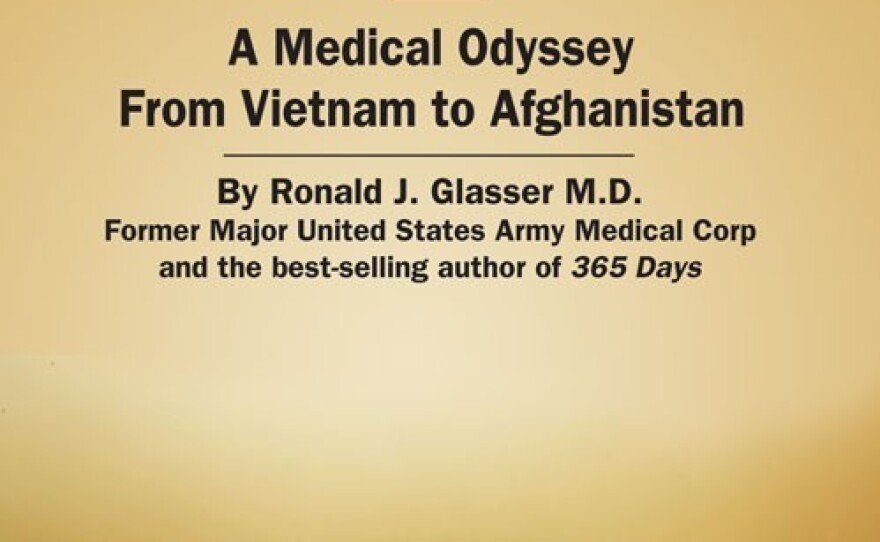

There's a new type of tourniquet being issued to every Marine in Afghanistan, former military physician Dr Ron Glasser writes in his new book, Broken Bodies Shattered Minds: A Medical Odyssey from Vietnam to Afghanistan. It's called a combat action tourniquet — essentially a plastic cinch soldiers pull to tighten.
Marines, without anyone ordering them to do so, have begun heading out on foot patrols with the tourniquets already loosely strapped around their thighs, so they can be tightened quickly if a foot or a leg is blown off.
Officers don't like it.
"They view it has a kind of defeatism on the part of the troops," Glasser tells weekends on All Things Considered host Rachel Martin.
The officers feel that by wearing the tourniquet, Marines are resigning themselves to the fact they'll be wounded.
"But the Marines don't care," Glasser says. "The basically say, 'The hell with it. We're going to wear it anyway. If our legs get blown off, at least we'll survive.'"
The tourniquet's use in Afghanistan highlights what Glasser says is a fundamental difference between modern warfare and Vietnam, or anything that preceded it. That difference is increasingly challenging for the world of military medicine.
"In Vietnam, you were shot," he says. "In Afghanistan, you're being blown up."
'It's Hardly Improvised'
The biggest threats troops face in Iraq and Afghanistan are landmines, improvised-explosive devices and other roadside explosives, Glasser says.
"And it's a misnomer," he adds.
An IED made with .355 mm shells wired together in a butane canister generates a 7,000 degree Fahrenheit blast wave that travels at 14,000 feet a second and can overturn a 60-ton M1A1 tank.
"It's hardly improvised," Glasser says.
Even cutting-edge body armor that protects from the side, front and rear does little to protect against explosives that are so often buried in the ground.
"So when you get your leg blown off, the chances are that you're going to have a genital injury," Glasser says. "And the understanding of this throughout the military is quite substantial."
So substantial, he says, that male troops shipping to Iraq and Afghanistan are given informal recommendations to store their sperm.
"The Army doesn't recommend it, nor does the Army like having anybody hear about" it, he says.
The Irritable Heart
One important medical success to come out of Afghanistan and Iraq, Glasser says, is the connection between traumatic brain injury and post-traumatic stress disorder — and the recognition that PTSD is not a psychological injury but a physiological one.
"In our Civil War, it was called 'melancholia' — this desire for home," Glasser says. "Then it became 'the irritable heart,' because the soldiers were shaking."
In World War II, it was "combat neurosis."
And though the military is exercising more diligence in its diagnosis and treatment of PTSD, Glasser says, it's still "overwhelmed" by the number of cases — partly because of the wide use of explosives and resulting cases of TBI.
"There are groups of Marines — three or four deployments — where everybody has been exposed to an IED," he says. "If you're standing 20 meters away from one, you're going to get your head rattled."
More Survivors, More Walking Wounded
With the increased awareness of TBI and PTSD, Glasser says medics in particular may be more likely to recognize their own psychological scarring.
"But it's tough," he says. "It's tough to admit that you can't sleep at night. It's tough to admit that when a car backfires, you really get scared."
One reason there are more soldiers returning home with symptoms of PTSD is that more soldiers are returning home.
In Vietnam, Glasser says, there were 2.4 casualties for every death. Today that ratio is 16-to-1.
"That's the reason the VA is being overwhelmed," Glasser says, referring to the Department of Veterans Affairs. "Nobody expected 16 casualties for every death."
Those added survivors, though, have contributed to the growing body of research linking brain injury and mental disorder. Glasser, still a practicing physician, says that's something that will benefit all of medicine.
"But it also goes to show — different wars, different tactics, different injuries," he says.
Copyright 2023 NPR. To see more, visit https://www.npr.org. 9(MDAzMjM2NDYzMDEyMzc1Njk5NjAxNzY3OQ001))






